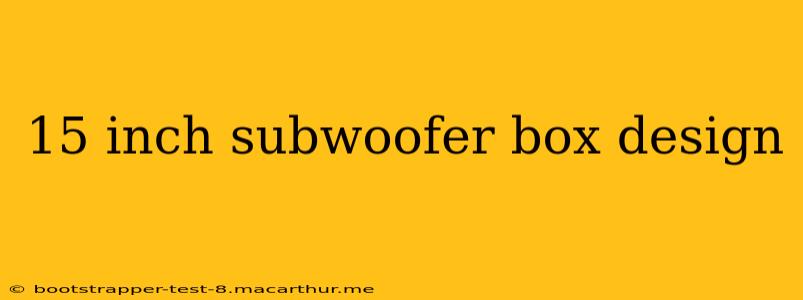Choosing the right enclosure for your 15-inch subwoofer is crucial for achieving optimal sound quality. A poorly designed box can lead to muddy bass, reduced output, and even damage to your subwoofer. This guide delves into the key considerations for designing a 15-inch subwoofer box, covering different enclosure types and the factors influencing their performance.
What are the Different Types of Subwoofer Boxes?
Several enclosure types cater to different sonic preferences and subwoofer characteristics. Understanding their strengths and weaknesses is vital for making an informed decision.
-
Sealed (Acoustic Suspension): Sealed boxes are simple to build, offering tight, accurate bass with good transient response. They're less prone to port noise and are generally better suited for smaller subwoofers or those with a higher resonant frequency (Fs). However, they typically offer less overall output compared to ported designs.
-
Ported (Bass Reflex): Ported boxes utilize a port (tube) to extend the low-frequency response, resulting in louder bass at lower frequencies. They're ideal for maximizing output but require more careful design to avoid port chuffing (distortion caused by excessive air movement) and resonance issues.
-
Bandpass: Bandpass enclosures are more complex, using two chambers and multiple tuned ports to create a narrow band of amplified frequencies. They offer incredibly high output within that specific frequency range but lack the versatility of sealed or ported designs. These are generally for experienced builders and specific applications.
-
Horn: Horn-loaded subwoofers provide exceptional efficiency and high output at low frequencies. However, these are significantly more complex to design and build, often requiring large volumes and precise horn geometry. They're not commonly used for home audio applications.
What are the Key Factors to Consider When Designing a 15-Inch Subwoofer Box?
Designing the perfect enclosure involves several crucial calculations and considerations:
-
Subwoofer Parameters (Thiele-Small Parameters): These parameters (Fs, Qms, Qes, Qts, Vas, etc.) provided by the subwoofer manufacturer are essential for accurate box design. These numbers dictate the optimal enclosure volume and tuning frequency for your specific subwoofer.
-
Enclosure Volume: The internal volume of the box directly impacts the low-frequency response. Too small a box can lead to excessive bass boost and distortion, while too large a box may result in weak, muddy bass. Accurate volume calculations using the Thiele-Small parameters are critical.
-
Tuning Frequency (for Ported Boxes): The tuning frequency of a ported enclosure determines the frequency at which the port resonates, impacting the overall sound. Proper tuning frequency calculation is crucial for maximizing output and minimizing distortion.
-
Port Length and Diameter: The length and diameter of the port in a ported enclosure significantly affect its tuning frequency and air velocity. Incorrect dimensions can lead to port noise or other undesirable effects.
-
Internal Bracing: Internal bracing helps to strengthen the box and reduce unwanted vibrations, improving sound quality and overall durability.
How Do I Calculate the Right Box Size for My 15-Inch Subwoofer?
There are numerous online calculators and software programs available to assist with box design calculations based on your subwoofer's Thiele-Small parameters. These tools simplify the process and ensure accurate results, preventing costly mistakes. Remember to always double-check your calculations and consider the tolerances involved in construction.
What Materials Should I Use to Build My Subwoofer Box?
Common materials for subwoofer boxes include MDF (medium-density fiberboard), plywood, and particleboard. MDF is a popular choice due to its density and ability to minimize vibrations. Plywood offers greater strength but may be more challenging to work with. Ensure your chosen material is appropriately thick to withstand the pressure generated by the subwoofer.
What is the Best Box Design for a 15-Inch Subwoofer?
There isn't a single "best" design. The optimal design depends entirely on your specific subwoofer, the desired sonic characteristics (e.g., tight and accurate bass vs. maximum output), and the available space. Consider experimenting with different designs or consulting with audio professionals to find the best solution for your needs. A well-designed sealed enclosure offers a safer starting point for beginners.
Can I Use a Ready-Made Subwoofer Box?
Yes, commercially available subwoofer boxes are readily available. However, these often come with limitations, and the design might not be perfectly optimized for your specific subwoofer. Building your own box allows for greater customization and control over the final result.
This guide provides a foundation for understanding 15-inch subwoofer box design. Remember that accurate calculations, quality materials, and meticulous construction are key to achieving optimal performance. Always prioritize safety and consult resources like Thiele/Small parameter calculators to create a custom enclosure that perfectly complements your subwoofer.
